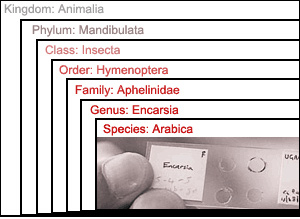|

For biologists, categorizing living things is
the key to understanding life on earth. They do
this through taxonomy, the classification of living
things within hierarchically-organized categories.
One of their main goals is to identify new species,
the most specific of the categories they use to
group organisms.

|
|
All
organisms can be classified within seven levels
of taxonomic categories. The wasp
Encarsia
arabica
, for example, is part of the
kingdom animalia, which includes all animals.
This kingdom is divided into several phyla,
such as
Mandibulata
, which is made
up of animals that have hard, segmented bodies
and characteristic jaw bones. This phylum
is further divided into several classes. One
of these classes,
Insecta
, includes
organisms with antennae and a pair of compound
eyes. The wasp's other traits allow biologists
to place it into increasingly refined categories,
including the most specific level of classification:
species.
|
To determine whether specimens belong to the
same species, biologists look at their body form,
their body chemistry, how they develop, and how
they behave. In general, only organisms that can
produce healthy offspring together are part of
the same species. Many types of orchids, though
they look similar, are unable to breed with one
another, and therefore don't belong to the same
species. Dogs, on the other hand, come in a huge
variety of shapes and sizes. But since they can
all mate with one another, they share the same
species name.
If defining a species is difficult, it may be
because life is continually—although very
slowly—changing. Scientists' current classifications
are like snapshots of a moving scene. But by studying
the species that exist today, biologists can better
understand how the living world came to be the
way it is, and how it might be changing.
|